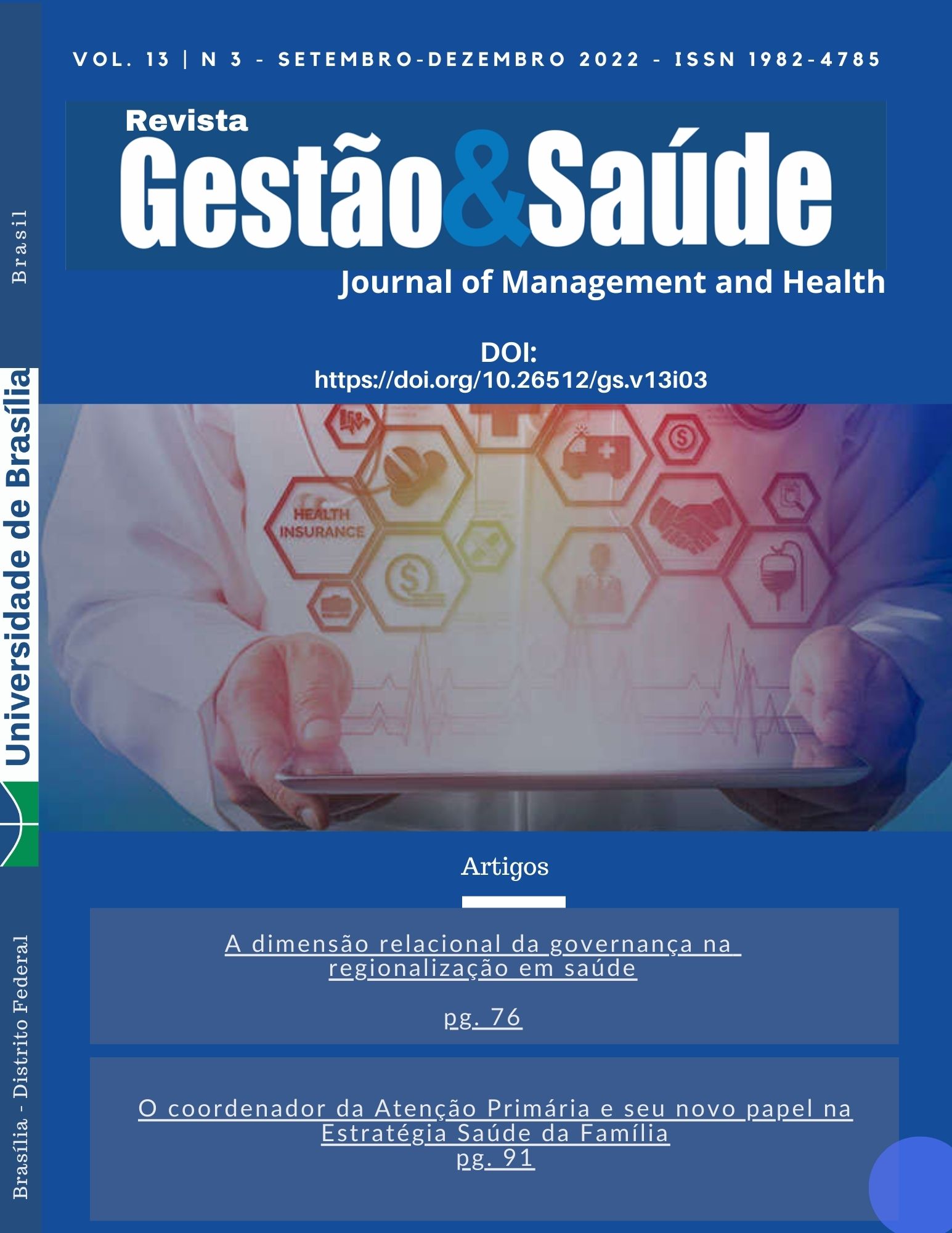The Primary Care coordinator and his new role in the Family Health Strategy
DOI:
https://doi.org/10.26512/gs.v13i03.46397Keywords:
Primary Health Care, Family Health Strategy, Health Management, Health ManagerAbstract
Since the beginning of the Family Health Strategy (ESF) in the Federal District (DF), some changes in the work process have been gradually incorporated; however, it can be observed that some coordinators tend to isolate themselves, accommodating in their functions and demonstrating resistance to act in different programs. Coordinators need to be aware that health actions within the new model are carried out according to the epidemiological data of each enrolled region, and it is important to expand their views beyond their program. A qualitative research was carried out with the application of a semistructured interview. The findings showed some coordinators believe that the ESF was inefficiently implemented, with lack of resources and planning, resulting in discredit from health professionals and the population. Other coordinators pointed as main difficulties the fragmentation of care, lack of support from local managers for changing the model, shortage of human resources, demand incompatible with the installed capacity and difficulty of communication between the ESF and the Health Center. It can be concluded that the coordinators understand how the ESF works and have sought to strengthen ties with the teams and work in an integrated way.
Downloads
References
Schimith MD; Brêtas ACP; Simon BS; BRUM DJT; Alberti GF; Bidó MLD; et al. Precarização e fragmentação do trabalho na Estratégia Saúde da Família: impactos em Santa Maria (RS). Trabalho, Educação e Saúde, v. 15, n. 1, 2017. Disponível em: https://doi.org/10.1590/1981-7746-sol00038. Acesso em: 09 dez 2022.
Marsiglia RMG; Sala ADA; Luppi CG; Valéria J; Spinelli SP, Carreira MO, et al. Integralidade e Atenção Primária em Saúde: avaliação da organização do processo de trabalho em unidades de saúde da Secretaria Municipal da Saúde de São Paulo. 2006. Disponível em: http://bases.bireme.br/cgi-bin/wxislind.exe/iah/online/?IsisScript=iah/iah.xis&src=google&base=LILACS&lang=p&nextAction=lnk&exprSearch=607189&indexSearch=ID. Acesso em: 09 dez 2022.
Aquino DI; Taveira Conceição CRFR; Pereira CRC. A família contemporânea e a Estratégia de Saúde da Família: uma revisão integrativa. Revista Eletrônica Estácio Saúde, v. 6, n. 1, 2017. Disponível em: http://revistaadmmade.estacio.br/index.php/saudesantacatarina/article/viewFile/3661/1576. Acesso em: 09 dez 2022.
Malta DC; Santos MAS, Stopa SR; Vieira JEB, Melo EA, Reis AAC. A cobertura da Estratégia de Saúde da Família (ESF) no Brasil, segundo a Pesquisa Nacional de Saúde, 2013. Ciência & Saúde Coletiva, v. 21, n. 2, 2016. Disponível em: https://doi.org/10.1590/1413-81232015212.23602015. Acesso em: 09 dez 2022.
Heimann LS; Mendonça MH. A trajetória da Atenção Básica em Saúde e do Programa Saúde da Família no SUS: uma busca de identidade. Saúde e democracia: história e perspectivas do SUS. Rio de Janeiro: Fiocruz, 2005.
Brasil. Ministério da Saúde. Diretrizes Nacionais para a Atenção Integral à Saúde de Adolescentes e Jovens na promoção, proteção e recuperação da saúde. Brasília; 2010. Disponível em: http://bvsms.saude.gov.br/bvs/publicacoes/diretrizes_nacionais_atencao_saude_adolescentes_jovens_promocao_saude.pdf. Acesso em: 09 dez 2022.
Souza KR; Kerbauy MTM. Abordagem quanti-qualitativa: superação da dicotomia quantitativa-qualitativa na pesquisa em educação. Educação e Filosofia, v. 31, n. 61, 2017. Disponível em: http://dx.doi.org/10.14393/REVEDFIL.issn.0102-6801.v31n61a2017-p21a44. Acesso em: 11 dez 2022.
Minayo MCS. O desafio do conhecimento: pesquisa qualitativa em saúde. 14 ed. São Paulo: Hucitec; 2014.
Caregnato RCA; Mutti R. Pesquisa qualitativa: análise de discurso versus análise de conteúdo. Texto Contexto Enfermagem, v. 15, n. 4, 2006. Disponível em: https://www.scielo.br/pdf/tce/v15n4/v15n4a17.pdf. Acesso em: 09 dez 2022.
Starfirdl B. Atenção Primária: equilíbrio entre necessidades de saúde, serviços e tecnologia. 2002. Disponível em: http://bvsms.saude.gov.br/bvs/publicacoes/atencao_primaria_p1.pdf. Acesso em: 11 dez 2022.
Santos RABG; Uchôa-Figueiredo LR; Lima LC. Apoio matricial e ações na Atenção Primária: experiência de profissionais de ESF e Nasf. Saúde em Debate, v. 41, n. 114, 2017. Disponível em: https://doi.org/10.1590/0103-1104201711402. Acesso em: 09 dez 2022.
Neves RG; Flores TR; Duro SMS; Nunes BP. Tendência temporal da cobertura da Estratégia Saúde da Família no Brasil, regiões e Unidades da Federação, 2006-2016. Epidemiologia e Serviços de Saúde, v. 27, n. 3, 2018. Disponível em: https://doi.org/10.5123/S1679-49742018000300008. Acesso em: 09 dez 2022.
Vasconcelos KEL; Shmaller VPV. Estratégia Saúde da Família: foco da disputa entre projetos sanitários no Brasil. Sociedade em Debate, v. 17, n. 1, 2011. Disponível em: http://revistas.ucpel.edu.br/index.php/rsd/article/view/686. Acesso em: 11 dez 2022.
Brasil. Ministério da Saúde. HumanizaSUS: documento base para gestores e trabalhadores do SUS. Brasília;2010. Disponível em: http://bvsms.saude.gov.br/bvs/publicacoes/humanizasus_documento_gestores_trabalhadores_sus.pdf. Acesso em: 09 dez 2022.
Ribeiro FA. Atenção Primária e Sistema de Saúde no Brasil: uma perspectiva histórica [dissertação]. São Paulo: Universidade de São Paulo, 2007.
Simoni C. O processo de parametrização do CSS01- Sobradinho-DF. Disponível em: http://atencaobasica.org.br/relato/1948#sthash.tKMeKOyi.dpuf. Acesso em: 11 dez 2022.
Sena LA; Cavalcanti RP; Pereira IL; Leite SRR. Intersetorialidade e ESF: limites e possibilidades no território de uma Unidade Integrada de Saúde da Família. Revista Brasileira de Ciências da Saúde, v. 16, n. 3, 2012. Disponível em: https://periodicos.ufpb.br/ojs/index.php/rbcs/article/view/12803. Acesso em: 11 dez 2022.
Castro RCL; Knauth DR; Harzheim E; Hauser L; Duncan BB. Avaliação da qualidade da Atenção Primária pelos profissionais de saúde: comparação entre diferentes tipos de serviços. Cadernos de Saúde Pública, v. 28, n. 9, 2012. Disponível em: http://dx.doi.org/10.1590/S0102-311X2012000900015. Acesso em: 09 dez 2022.
Downloads
Published
How to Cite
Issue
Section
License
Copyright (c) 2023 ELECTRONIC JOURNAL MANAGEMENT AND HEALTH

This work is licensed under a Creative Commons Attribution-NoDerivatives 4.0 International License.
I declare that this article is original and has not been submitted for publication in any other national or international journal, either in whole or in part. I further declare that once published in the Electronic Journal Management and Health published by the University of Brasília, it will never be submitted by me or any of the other coauthors to any other means of scientific dissemination.
Through this instrument, in my name and in the name of the other coauthors, may I soon copy the copyright of the article to Electronic Journal Management and Health and declare that I am aware that failure to comply with this commitment will subject the violator to penalties and penalties Law of Protection of Rights Authorities (Nº9609, of 02/19/98).


